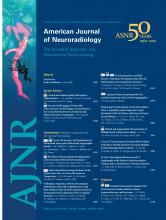Research ArticleFunctional
Feasibility and Efficacy of Transcranial Motor-Evoked Potential Monitoring in Neuroendovascular Surgery
T.G. Horton, M. Barnes, S. Johnson, P.C. Kalapos, A. Link and K.M. Cockroft
American Journal of Neuroradiology October 2012, 33 (9) 1825-1831; DOI: https://doi.org/10.3174/ajnr.A3017
T.G. Horton
aFrom the Departments of Neurosurgery (T.G.H., P.C.K., K.M.C.)
M. Barnes
cImpulse Monitoring, Inc. (M.B., S.J., A.L.), Columbia, Maryland.
S. Johnson
cImpulse Monitoring, Inc. (M.B., S.J., A.L.), Columbia, Maryland.
P.C. Kalapos
aFrom the Departments of Neurosurgery (T.G.H., P.C.K., K.M.C.)
bRadiology (P.C.K., K.M.C.), Penn State Hershey Medical Center, Hershey, Pennsylvania
A. Link
cImpulse Monitoring, Inc. (M.B., S.J., A.L.), Columbia, Maryland.
K.M. Cockroft
aFrom the Departments of Neurosurgery (T.G.H., P.C.K., K.M.C.)
bRadiology (P.C.K., K.M.C.), Penn State Hershey Medical Center, Hershey, Pennsylvania

References
- 1.↵
- Liu AY,
- Lopez JR,
- Do HM,
- et al
- 2.↵
- 3.↵
- Neuloh G,
- Schramm J
- 4.↵
- Kang D,
- Wu Z,
- Lan Q,
- et al
- 5.↵
- 6.↵
- 7.↵
- 8.↵
- Szelenyi A,
- Kothbauer K,
- Deletis V
- 9.↵
- Grundy B
- 10.↵
- Harner R
- 11.↵
- Neuloh G,
- Schramm J
- 12.↵
- 13.↵
- Szelenyi A,
- Langer D,
- Kothbauer K,
- et al
- 14.↵
- Quinones-Hinojosa A,
- Alam M,
- Lyon R,
- et al
In this issue
Advertisement
T.G. Horton, M. Barnes, S. Johnson, P.C. Kalapos, A. Link, K.M. Cockroft
Feasibility and Efficacy of Transcranial Motor-Evoked Potential Monitoring in Neuroendovascular Surgery
American Journal of Neuroradiology Oct 2012, 33 (9) 1825-1831; DOI: 10.3174/ajnr.A3017
0 Responses
Jump to section
Related Articles
- No related articles found.
Cited By...
This article has not yet been cited by articles in journals that are participating in Crossref Cited-by Linking.
More in this TOC Section
Similar Articles
Advertisement











